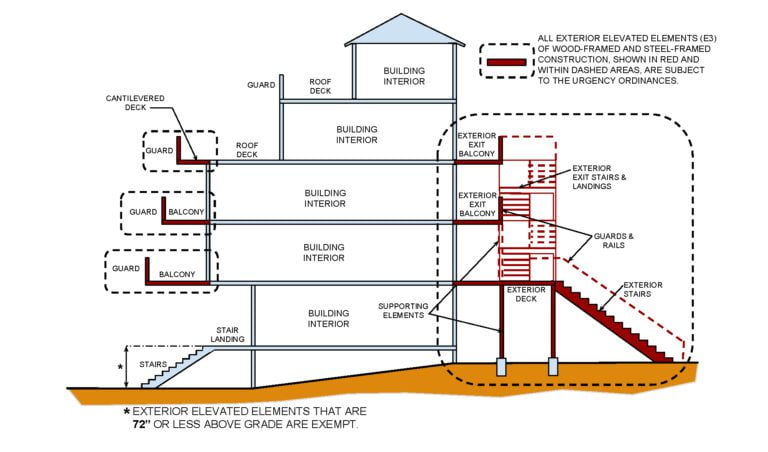
State-mandated inspections for multi-residential dwellings must be completed by Jan. 1, 2025
By Barbara Burke
Special to The Malibu Times
A group of building and architectural professionals, members of homeowners associations, and citizens who own condominium complexes or other multi-residential dwellings in the City of Malibu met with representatives of the city on March 12 to learn how to comply with a new, state-mandated requirement entitled Exterior Elevated Elements (E3) Program, which mandates that, by Jan. 1, 2025, E3s in multi-family buildings with three or more dwelling units must be inspected by a California-licensed architect, or a California-licensed civil or structural engineer. Affected properties include condominiums, apartments, hotels, motels, vacation timeshare properties, dormitories, fraternities and sororities, and social rehabilitation centers.
The meeting was led by Building Safety Department Official Yolanda Bundy who carefully explained what the new law requires and what building elements it concerns. E3’s include balconies, exterior walkways, decks, exterior stairs and landings, and guards and associated handrails, Yolanda stated. The new requirements were implemented by the City of Malibu as mandated by the California Legislature’s enactment of SB 721 and SB 326, cumulatively referred to as the Balcony Inspection Bill. On Sept. 17, 2018, Governor Jerry Brown signed the bills into law. SB 721 relates to commercial apartment buildings, while SB 326 relates to condominiums or multi-family housing that are controlled by residential condominium associations.
The bills were enacted in response to the tragic deaths of six Berkeley students in 2015 at an apartment complex due to the collapse of a balcony. Readers may recall that in 2021, 9 people were injured when a balcony at a beachfront Malibu home collapsed, sending victims onto rocks below.
To comply with the new laws, in February, the Malibu City Council approved an ordinance requiring inspections that comply with state standards. The ordinance requires periodic inspections on multifamily buildings with three or more attached units. Owners have until Jan. 1, 2025, to complete the first inspection. For those structures that pass such inspections, another assessment must be completed every six to nine years, depending on the property’s classification.
Attendees sought clarity concerning how to comply with the law. Bundy explained that the inspection report is a legal document that will be part of a property’s report.
“The goal of this program is to ensure that buildings are safe for occupants and visitors,” Bundy emphasized. “We here at the city are here to help you comply with the requirements and answer all of your questions.”
Materials distributed by the city provided more details, stating, “The program’s purpose is to safeguard public safety by maintaining the strength of structural components supporting E3s.”
Program objectives include identifying wood-framed E3s exhibiting significant deterioration due to wood-destroying organisms such as fungal decay or insect infections, identifying steel-framed E3s exhibiting significant section loss due to corrosion, and ascertaining whether the extent of deterioration or corrosion poses a significant compromise to the load-carrying adequacy of structural components supporting E3s. Inspectors should try to locate the water source if wood is being destroyed by organism infestation or corrosion is observed in wood or steel framing.
“The assessment is first done by a Tier 1 screening and a Tier 2 evaluation and remediation, if necessary,” Bundy said. “Those terms are defined in the American Society of Civil Engineers Code 41-17.”
She explained that Tier 1 screenings must be completed by a California-licensed architect, civil engineer, or structural engineer. If a Tier 2 remediation is required, the owner should schedule an appointment with the building official to confirm the extent of remediation required. One accomplishes that by emailing Senior Civil Engineer Andre Ketchedjian at aketchedjian@malibucity.org or calling (310) 456-2489, ext. 299.
“We are here to meet with owners to clarify exactly what repairs must be done to remediate any concerns,” Bundy said. “Those who need to repair their E3s must obtain the necessary permits, and if urgently needed repairs are required, we can help an owner get the permits expeditiously.”
Noting that there are 25 condo associations in Malibu and each one has 100 or more units, Bundy acknowledged the extent of the program, but emphasized that the city stands ready to help owners to ensure they comply with the laws.
Attendees expressed concerns about the expenses they would incur to comply with the new law. Further, several stated that many architects would not want to conduct the inspections due to liability concerns.
Architect Richard Sol noted that some condos in Malibu were constructed in the 1960s and 1970s and owners may face significant expense in complying with the law. Then, there were concerns regarding who to find a proper.
“It might be very helpful as you try to find a professional to conduct the assessment to contact the original architect or the builder of record because they are already familiar with the property,” Bundy noted.
For more information go to Malibucity.org/E3.
Future Information Meetings are Scheduled:
April 4, from 12 to 1 p.m.
April 9, from 3 to 4 p.m.
May 16, from 12 to 1 p.m.